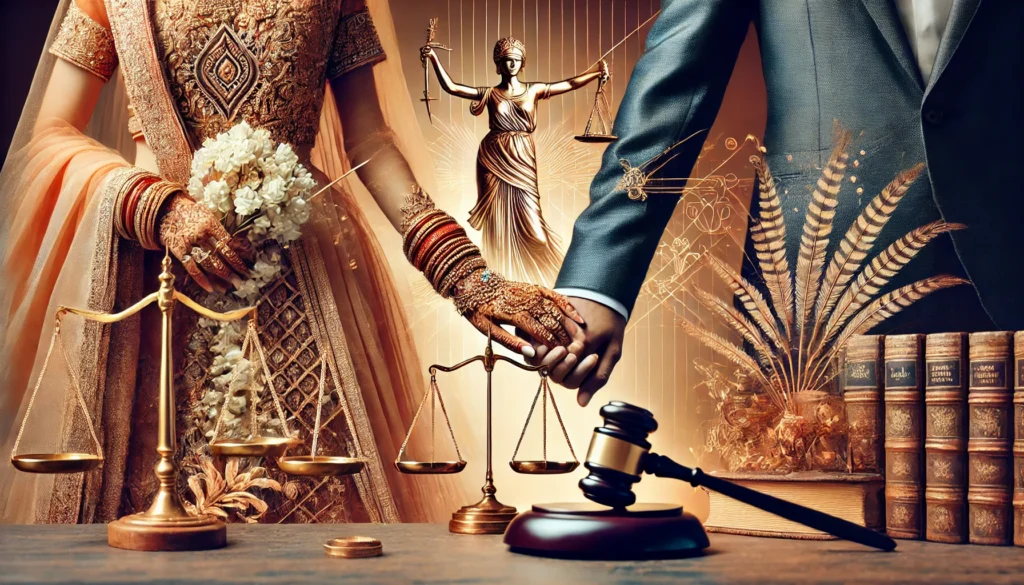Published on: 1st November 2024
Authored by: Ritu Raj
S.S Khanna Girls Degree College
ABSTRACT
This article examines prominent marriage laws in India and their provisions. Marriage laws in India vary based on religion. This paper analyzes conjugal bonds and the legal qualifications required to establish such bonds, covering the Hindu Marriage Act, 1955, Muslim Marriage Law, Special Marriage Act, 1954, Indian Christian Marriage Act, 1872, and Parsi Marriage and Divorce Act, 1936. The article also explores the issues of child marriage, its consequences, punishments, and the ongoing debate around same-sex marriage. Additionally, it discusses the significance of the Uniform Civil Code.
Keywords: Hindu Marriage Act, 1955, Special Marriage Act, 1954, Muslim Marriage Law, Indian Christian Marriage Act, 1872, Parsi Marriage and Divorce Act, 1936, Same-Sex Marriage, Uniform Civil Code (UCC).
INTRODUCTION
Marriage is a primary institution through which individuals are introduced to family life. Traditionally, only the union of a man and woman is seen as the foundation of a family, established either through religious ceremonies or legal contracts. In India, marriage is regarded as a sacred duty, believed to bind individuals in a lifelong commitment that extends beyond death. However, in the case of Muslim marriages, it is seen as a civil contract that can be dissolved through legally recognized divorce procedures, making marriage revocable in nature.
Marriage fulfills vital social needs, including care, affection, companionship, sexual satisfaction, and procreation. According to the Manusmriti, the four purposes of marriage are:
1. Progeny
2. Fulfillment of desires
3. Freedom from parental debt
4. Religious duty
Marriage can be classified as:
– Endogamy: Marriage within one’s caste, religion, or other social boundaries.
– Exogamy: Marriage outside one’s caste, religion, or other boundaries.
EVOLUTION OF MARRIAGE
Historical evidence suggests that marriage is approximately 4,350 years old. According to *The Week*, the earliest recorded marriage, dating back to around 2350 B.C. in Mesopotamia, was initially centered on political and economic alliances rather than personal affection. Over time, marriage evolved into a union based on companionship and individual fulfillment. Initially conducted through religious rituals, marriages today can also be solemnized in court. Divorce and remarriage, once taboo, are now more common, reflecting a shift in the values associated with marriage.
In India, marriage laws vary by religion and are categorized as personal or family laws. The main marriage laws are:
– Hindu Marriage Act, 1955
– Muslim Marriage Law
– Indian Christian Marriage Act, 1872
– Special Marriage Act, 1954
– Parsi Marriage and Divorce Act, 1936
– Marriage Registration Laws
– Court Marriage Laws
– Child Marriage Restraint Act, 1929
– Same-Sex Marriage Law
THE HINDU MARRIAGE ACT, 1955
Enacted by Parliament on May 18, 1955, the Hindu Marriage Act codifies marriage laws for Hindus, Buddhists, Jains, and Sikhs. Section 2 of this Act defines “Hindu” inclusively. Section 5 specifies the conditions for a valid Hindu marriage, including prohibition of bigamy, free consent, minimum age requirements (21 for men and 18 for women), and restriction of marriage within prohibited degrees of relationship or sapinda.
MUSLIM MARRIAGE LAW
In Islam, marriage, or “Nikah,” is primarily a civil contract, completed through proposal (ijab) and acceptance (qubool) in the presence of a cleric and two witnesses. Requirements for a valid marriage include the Muslim faith of both parties, legal age, capacity to consent, and adherence to Islamic law. Muslim marriages also allow for the concept of “muta” marriage, which Sunni jurisprudence largely prohibits.
THE INDIAN CHRISTIAN MARRIAGE ACT, 1872
Passed in 1872, this Act codifies the marriage laws for Christians in India. Section 3 defines “Christian,” while Section 60 outlines marriage requirements, such as legal age (21 for men and 18 for women), prohibition of bigamy, and consent without coercion. Christian marriages are generally conducted under church supervision and require the presence of two witnesses.
THE SPECIAL MARRIAGE ACT, 1954
This Act facilitates inter-caste and inter-religious marriages, aiming to eliminate religious discrimination in marriage. Section 4 outlines the conditions for a valid marriage under this Act, including legal age, mental soundness, prohibition of bigamy, and registration requirements. Unlike religious ceremonies, marriages under this Act are validated through court proceedings.
THE PARSI MARRIAGE AND DIVORCE ACT, 1936
The Parsi community considers marriage a contract, with religious ceremonies like Ashirwad (blessings) essential for validity. Section 3 outlines requirements, including prohibition of marriage within consanguinity, presence of witnesses, and legal age (18 for women, 21 for men). Bigamy is prohibited, and violation can lead to punishment under Section 5.
MARRIAGE REGISTRATION IN INDIA
Marriage registration, akin to registering birth or death, provides legal recognition and protects individuals’ rights, particularly those of women regarding property, child custody, and spousal support. Registration is mandatory under various Acts like the Hindu Marriage Act, 1955, Special Marriage Act, 1954, and Indian Christian Marriage Act, 1872. The Supreme Court has emphasized the need for marriage registration as conclusive proof of marital status.
COURT MARRIAGE REGISTRATION IN INDIA
Court marriage, conducted under the Special Marriage Act, 1954, allows couples of any caste or religion to marry. The process, uniform across Indian states, requires presence before the registrar, submission of essential documents (such as age and marital status proof), and observance of a 30-day waiting period after filing the marriage notice.
CHILD MARRIAGE
Child marriage, a persisting social evil, violates basic human rights. Despite laws prohibiting it, child marriage endures in parts of India. The Child Marriage Restraint Act, 1929, imposes penalties on adult men marrying minors and holds parents accountable. The Prohibition of Child Marriage Act, 2006, further empowers parties to void a child marriage at their option.
SAME-SEX MARRIAGE
Same-sex marriage, though socially debated, lacks legal recognition in India due to concerns around procreation and inheritance. However, recent Supreme Court judgments (August 2022) affirm limited rights for same-sex couples to cohabit. Full legal recognition remains in Parliament’s jurisdiction.
UNIFORM CIVIL CODE
India’s diverse personal laws govern areas such as marriage, inheritance, and divorce. The Hindu Marriage Act is largely codified, while Muslim marriage law remains largely uncodified. Personal laws contribute to communalism and gender inequality. A Uniform Civil Code (UCC) would protect the marital rights of vulnerable groups, unify national laws, and promote secularism.
CONCLUSION
In India, marriage is a revered institution based on love, trust, and understanding. Despite its patriarchal undertones, evolving laws aim to secure basic rights for spouses. By unifying marriage laws under a UCC, India could strengthen its “unity in diversity” while ensuring equality and justice for all.
References:
1. The Hindu Marriage Act, 1955, Government of India.
2. The Indian Christian Marriage Act, 1872, Government of India.
3. The Special Marriage Act, 1954, Government of India.
4. The Parsi Marriage and Divorce Act, 1936, Government of India.
5. Child Marriage Restraint Act, 1929, Government of India.
6. The Prohibition of Child Marriage Act, 2006, Government of India.
7. Supreme Court of India, Judgment on Same-Sex Cohabitation Rights, August 2022.
8. Staff, T.W. (2007) The origins of Marriage, theweek. Available at: https://theweek.com/articles/528746/origins-marriage (Accessed: 01 November 2024).




